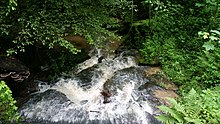Kirchenkirnberg
|
Kirchenkirnberg
City of Murrhardt
|
|
|---|---|
| Coordinates: 48 ° 57 ′ 1 ″ N , 9 ° 40 ′ 58 ″ E | |
| Height : | 460 m above sea level NHN |
| Area : | 12.32 km² |
| Residents : | 560 (Jun 30, 2015) |
| Population density : | 45 inhabitants / km² |
| Incorporation : | July 1, 1971 |
| Postal code : | 71540 |
| Area code : | 07184 |

Kirchenkirnberg is a district of the city of Murrhardt in the Rems-Murr district , named after the largest settlement area in it, the village of Kirchenkirnberg.
geography
From the village of Kirchenkirnberg it is about 8 km as the crow flies to the town center of Murrhardt in the west-northwest, about the same distance to the town center of Gaildorf in the northeast in the district of Schwäbisch Hall and about 4.5 km to the village center of the municipality of Gschwend in the east-southeast in the Ostalb district ; the distances on the road are sometimes significantly longer.
The village is about 460 m above sea level. NHN in the Kirnberger Wald sub- area of the Swabian-Franconian Forest Mountains natural area , which forms a first altitude step in the ascent from the valleys of Fichtenberger Rot and Kocher to the higher Welzheimer Wald and is drained from the Glattenzainbach northeast to the Rot. It has 560 inhabitants (as of June 30, 2015), while the other places in the district marking - the hamlets Gänshof, Gärtnershof, Göckelhof, Mettelbach, Oberneustetten, Spielhof, Täle, Tiefenmad, Untersteustetten, the courtyards Mutzenhof and Schloßmühle as well as the Leukers residential areas, Marxenhof, Reute, Vögelesreute and Wiesenhof - all are much smaller. These are mostly further to the west, partly in the sub-area Murrtal , partly even further west in the divided sub-area Murrhardter Wald ; the outflow from these parts of the district reaches the upper Murr at its upper course bend. The district area is predominantly forested, with the exception of the clearing island around Kirchenkirnberg and the playground as well as the broader valley floor of the water fan running towards the Murrknick. With about 316 m above sea level. It is deepest at the inflow of the Göckelbach to the Murr near the Göckelhof.
history
Church Kirnberg emerged in the recent expansion of time and was on May 2, 1182 as Curinberch first mentioned as the place owned by the monastery Murrhardt to the monastery Adelberg came. With the Reformation , Kirchenkirnberg became part of Württemberg . Kirchenkirnberg was part of the Adelberg Monastery Office and, when it was dissolved in 1807, it became part of the Welzheim District Office and when it was dissolved in 1938, it became part of the Backnang district .
Before the Reformation, Kirchenkirnberg was a place of pilgrimage. A fair was held on Easter Monday. Under Duke Christoph Kirchenkirnberg lost the market rights on February 13, 1555 in favor of the city of Murrhardt. The village's request from 1570 for a new market right was rejected.
Small amounts of hard coal were mined near Kirchenkirnberg in the 16th and 17th centuries . When farmers rediscovered the tunnel, which until then was known as the “Geistloch” as a cave, around 1790, attempts were made to mine coal again. This failed, however, because the tunnel could not be properly drained. New attempts in 1821 were also soon abandoned.
In 1809, Kirchenkirnberg became the seat of its own municipal administration. The parish Kirchenkirnberg was incorporated into Murrhardt on July 1, 1971. The community included the village of Kirchenkirnberg, the hamlets of Gänshof, Gärtnershof, Göckelhof, Mettelbach (a distinction is sometimes made between Ober- and Untermettelbach), Oberneustetten, Spielhof, Täle , Tiefenmad, Untersteustetten, the Mutzenhof and Schloßmühle farms and the Leukers, Marxenhof, Reute residential areas , Vögelesreute and Wiesenhof. In addition, the hamlet of Bruch and the residential areas Weidenhof and Weidenbach, which today belong to the municipality of Kaisersbach. The community had an area of 12.32 km².
coat of arms
The blazon of the former municipal coat of arms reads: "Under the black shield head, inside three golden pine cones next to each other, in gold a black mill wheel."
Individual evidence
- ↑ Population according to "Facts and Figures" on the city's internet site , which it dates to June 31, 2015.
- ^ Federal Statistical Office (ed.): Historical municipality directory for the Federal Republic of Germany. Name, border and key number changes in municipalities, counties and administrative districts from May 27, 1970 to December 31, 1982 . W. Kohlhammer, Stuttgart / Mainz 1983, ISBN 3-17-003263-1 , p. 446 .
- ^ The state of Baden-Württemberg. Official description by district and municipality. Volume III: Stuttgart District, Middle Neckar Regional Association. Kohlhammer, Stuttgart 1978, ISBN 3-17-004758-2 , pp. 528-534.
literature
- The Rems-Murr district . Konrad Theiss publishing house. Stuttgart 1980. ISBN 3-8062-0243-5
- Eberhard Bohn & Gerhard Fritz. "Kirchenkirnberg. A parish village on the border". Hennecke 2004, ISBN 978-3-927981-79-9

